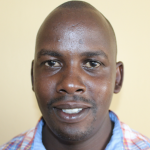The 41 staff members of Serem Health Center work hard to provide high-quality medical care for the surrounding community. On average, they serve 37 patients a day who come in for a wide range of medical concerns, from check-ups to maternity care to disease management. But without reliable, clean water, the standard of care becomes nearly impossible to maintain.

A patient carrying bathing water into the center.
The health center's only water option is to utilize a gutter system to collect rainwater. During the dry season, they rely on a water vendor to bring in water. That is a costly and dangerous solution, as the water vendors bring water from unknown and often contaminated sources.

Tank and gutter system currently used to collect water.
"[This] health care facility does purchase water from water vendors during dry spells as an alternative water source because the rainwater tanks in the facility are prone to seasonality. The water purchase will last them for a day, thus being costly to the facility. Since water vendors may supply water from any water source, it then compromises the quality of water being supplied to the health care facility and risks users of waterborne ailments," shared Field Officer Jonathon Mutai.

Patient consultation.
Imagine taking your sick child to the doctor who contracts a waterborne illness from consuming dirty water while at the clinic. A place of healing quickly becomes dangerous to their health.
Vita Presley, 31, is a Health Records and Information Officer at the Serem Health Center.

Vita Presley.
"The situation that causes [the] lack of water in our water source is [a] dry spell. Our main water sources, that is, rainwater tanks, rely fully on rain. So, every time there is [a] shortage of rains for quite some time, our water sources also run out of water," shared Mr. Presley.
Having no water available causes devastating effects on the care provided.
"The longest time I had to wait for water was about 4 hours. It was during [a] dry spell, and we had exhausted all water in the tanks within this health care facility. It was during those seasons when we had a lot of patients [become] victims of water-related illnesses. So, we had to order water, [and] the supplier took a longer time to deliver it," Mr. Presley continued.

Patient room.
Even when they do have water, it often makes the patients and staff sick.
Mr. Presley discussed the dangers of contaminated water. "It may lead to diseases causing micro-organisms and bacteria which cause infections like diarrhea. Also, toxic substances in dirty water may lead to long-term health issues."
"What impacted me on [the] one-on-one interaction with Vita is the time that mothers who have [just] delivered had to wait for bathing water during dry spells because the waterpoints in this health care facility are unreliable," Jonathon continued.

Staff washing bedding.
Implementing a well at the health care facility will provide the staff with the tools they need to provide the care their patients deserve. Serem Health Center will be a safe haven again for the community.

"The proposed water solution will be a reliable water source [that] will serve the health care facility throughout all seasons of the year. The water itself will be free from disease-causing micro-organisms; hence, users will [have access] to safe, clean water. Besides that, since it will not be affected by seasons, water can be pumped into [the] healthcare building and connected to several taps to help reduce overcrowding, which is currently experienced. Also, it will help the facility cut [down] on [the] cost of expenditure used on purchasing water from water vendors. And lastly, it will help ease general cleanliness in the health care facility," concluded Jonathon.
Steps Toward a Solution
Our technical experts worked with the local community to identify the most effective solution to their water crisis. They decided to drill a borehole well, construct a platform for the well, and attach a hand pump.
Well
Abundant water often lies just beneath our feet. Aquifers—natural underground rivers—flow through layers of sediment and rock, offering a constant supply of safe water. A borehole well is drilled deep into the earth to access this naturally filtered and protected water. We penetrate meters, sometimes even hundreds of meters, of soil, silt, rock, and more to reach the water underground. Once found, we construct a platform for the well and attach a hand pump. The community gains a safe, enclosed water source capable of providing approximately five gallons of water per minute. Learn more here!
Handwashing Stations
Alongside each water source, we install two gravity-fed handwashing stations, enabling everyone at the health center to wash their hands. Handwashing is crucial for preventing water-related illnesses within the health center and community. Health center staff will maintain the stations, fill them with water, and supply them with soap, which we often teach them how to make.
Latrines
We will construct two Ventilated Improved Pit (VIP) latrine blocks designed to prevent fecal disease transmission. Each latrine features a cement floor, making it easy to use and clean regularly. Three stalls will serve the women and girls, and three will serve the men and boys.
Health Center Education & Ownership
Hygiene and sanitation training are integral to our water projects. Training is tailored to each health center's specific needs and includes key topics such as proper water handling, improved hygiene practices, disease transmission prevention, and care of the new water point. Encouraged and supported by the guidance of our team, a water user committee comprises a community health volunteer, the staff in charge of the clinic, a community leader, and the health center board representative. They assume responsibility for maintaining the waterpoint, promoting safe hygiene and sanitation practices, and keeping handwashing stations well-stocked.
Safe water and improved hygiene habits foster a healthier future for everyone in the community.



 Rehabilitation Project
Rehabilitation Project




















